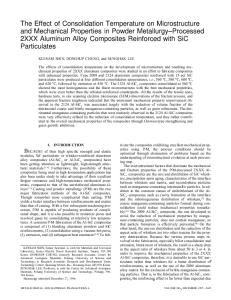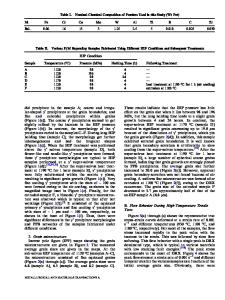Microstructure and mechanical behavior of ultrafine-grained Ni processed by different powder metallurgy methods
- PDF / 2,119,455 Bytes
- 10 Pages / 584.957 x 782.986 pts Page_size
- 85 Downloads / 287 Views
H-Q. Bui, F. Fellah, and G.F. Dirras Laboratoire des Proprie´te´s Me´caniques et Thermodynamiques des Mate´riaux–Centre National de la Recherche Scientifique, Universite´ Paris 13, 93430 Villetaneuse, France (Received 23 July 2008; accepted 29 September 2008)
Ultrafine-grained samples were produced from a Ni nanopowder by hot isostatic pressing (HIP) and spark plasma sintering (SPS). The microstructure and mechanical behavior of the two specimens were compared. The grain coarsening observed during the SPS procedure was moderated due to a reduced temperature and time of consolidation compared with HIP processing. The smaller grain-size and higher nickel-oxide content in the SPS-processed sample resulted in a higher yield strength. Compression experiments showed that the specimen produced by SPS reached a maximal flow stress at a small strain, which was followed by a long steady-state softening while the HIP-processed sample hardened until failure. It was revealed that the softening of the SPS-processed sample resulted from microcracking along the grain boundaries.
I. INTRODUCTION
Bulk ultrafine-grained (UFG) materials can be synthesized in two essentially different ways. The first one is a “top-down” approach, where the bulk coarse-grained materials are refined by severe plastic deformation (SPD).1–4 The second way for producing ultrafinegrained materials is a “bottom-up” approach, when samples are assembled from individual atoms or nanoparticles.5–7 Most bottom-up methods first produce nanopowders, which need to be consolidated in a second step. The ultrafine-grained microstructures obtained by powder sintering are less textured compared with the SPDprocessed materials. At the same time, the sintered materials often have undesired contamination and remaining porosity.8 To avoid porosity, sintering is usually carried out at elevated temperatures, such as in hot isostatic pressing (HIP), which usually results in grain coarsening.9 The grain growth can be moderated by optimizing the compaction parameters (temperature, pressure, and the duration of sintering), e.g., in spark plasma sintering (SPS), where the consolidation is assisted by electric current pulses.10–12 The physics of the consolidation process during SPS processing is not fully understood, a)
Address all correspondence to this author. e-mail: [email protected] Dedicated to Professor Georges Saada on the occasion of his award “Grande Me´daille, 2008” of the French Society of Metallurgy and Materials for his achievements in Physical Metallurgy. DOI: 10.1557/JMR.2009.0010 J. Mater. Res., Vol. 24, No. 1, Jan 2009
http://journals.cambridge.org
Downloaded: 13 Mar 2015
but its main characteristic is an ultrafast compaction at much lower temperatures than in the classic techniques, thus reducing grain growth.13 The study of the correlation between microstructure and mechanical behavior of bulk UFG samples produced by different powder metallurgy procedures is of great importance for practical applications. In this article, the microstructures and the mecha
Data Loading...











